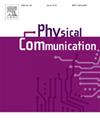Outage Probability Analysis For Dual-Hop Asymmetric Fading WBAN
IF 2
4区 计算机科学
Q3 ENGINEERING, ELECTRICAL & ELECTRONIC
引用次数: 0
Abstract
Wireless Body Area Networks (WBANs) involve wireless communication among resource constrained sensors located on the human body, which are used to capture physiological signals. A significant challenge faced by WBANs is their reliability. It is crucial to analyze the outage of the system to ensure improved reliability in the system design. This study focuses on analyzing the outage performance of dual hop WBANs under different fading scenarios, wherein the channel coefficients follow different distributions. Outage performance is evaluated using the CDF of the SNR of different fading scenarios. Furthermore, the outage performance of these fading distributions are compared to each other and a target outage probability of 10% was pre-set to evaluate the performance of the composite channels from worst to best. Results show that the minimum acceptable threshold SNRs at average SNR = 15 dB for Gamma-Weibull, Gamma-Log-Normal, Gamma-Rayleigh, Gamma–Gamma, Gamma-Rician and Gamma-Nakagami-m are - 4 dB, 2 dB, 4 dB, 6 dB, 8 dB and 10 dB respectively. The analytical outcomes for all the results for different cases are validated through Monte Carlo simulations. There is a lack of comprehensive frameworks in the literature that address all scenarios according to the authors’ knowledge.
双跳非对称衰落 WBAN 的中断概率分析
无线体域网(WBANs)涉及位于人体上的资源有限的传感器之间的无线通信,这些传感器用于捕捉生理信号。WBAN 面临的一个重大挑战是其可靠性。分析系统的中断情况对确保提高系统设计的可靠性至关重要。本研究重点分析双跳 WBAN 在不同衰落场景下的中断性能,其中信道系数遵循不同的分布。利用不同衰落场景下信噪比的 CDF 来评估中断性能。此外,还对这些衰减分布的中断性能进行了比较,并预先设定了 10% 的目标中断概率,以评估复合信道从最差到最佳的性能。结果显示,平均 SNR = 15 dB 时,Gamma-Weibull、Gamma-Log-Normal、Gamma-Rayleigh、Gamma-Gamma、Gamma-Rician 和 Gamma-Nakagami-m 的最小可接受阈值 SNR 分别为 - 4 dB、2 dB、4 dB、6 dB、8 dB 和 10 dB。通过蒙特卡罗模拟验证了不同情况下所有结果的分析结果。根据作者的了解,文献中缺乏针对所有情况的综合框架。
本文章由计算机程序翻译,如有差异,请以英文原文为准。
求助全文
约1分钟内获得全文
求助全文
来源期刊

Physical Communication
ENGINEERING, ELECTRICAL & ELECTRONICTELECO-TELECOMMUNICATIONS
CiteScore
5.00
自引率
9.10%
发文量
212
审稿时长
55 days
期刊介绍:
PHYCOM: Physical Communication is an international and archival journal providing complete coverage of all topics of interest to those involved in all aspects of physical layer communications. Theoretical research contributions presenting new techniques, concepts or analyses, applied contributions reporting on experiences and experiments, and tutorials are published.
Topics of interest include but are not limited to:
Physical layer issues of Wireless Local Area Networks, WiMAX, Wireless Mesh Networks, Sensor and Ad Hoc Networks, PCS Systems; Radio access protocols and algorithms for the physical layer; Spread Spectrum Communications; Channel Modeling; Detection and Estimation; Modulation and Coding; Multiplexing and Carrier Techniques; Broadband Wireless Communications; Wireless Personal Communications; Multi-user Detection; Signal Separation and Interference rejection: Multimedia Communications over Wireless; DSP Applications to Wireless Systems; Experimental and Prototype Results; Multiple Access Techniques; Space-time Processing; Synchronization Techniques; Error Control Techniques; Cryptography; Software Radios; Tracking; Resource Allocation and Inference Management; Multi-rate and Multi-carrier Communications; Cross layer Design and Optimization; Propagation and Channel Characterization; OFDM Systems; MIMO Systems; Ultra-Wideband Communications; Cognitive Radio System Architectures; Platforms and Hardware Implementations for the Support of Cognitive, Radio Systems; Cognitive Radio Resource Management and Dynamic Spectrum Sharing.
 求助内容:
求助内容: 应助结果提醒方式:
应助结果提醒方式:


